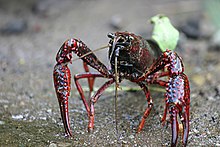Cambaridae
| Cambaridae | |
|---|---|

| |
| Procambarus clarkii | |
| Scientific classification | |
| Domain: | Eukaryota |
| Kingdom: | Animalia |
| Phylum: | Arthropoda |
| Class: | Malacostraca |
| Order: | Decapoda |
| Suborder: | Pleocyemata |
| Superfamily: | Astacoidea |
| Family: | Cambaridae Hobbs, 1942 |
| Genera | |
Cambaridae is the largest of the three families of freshwater crayfish, with over 400 species.[1] Most of the species in the family are native the United States east of the Great Divide and Mexico, but fewer range north to Canada, and south to Guatemala and Honduras. Three live on the island of Cuba. The species in the genus Cambaroides are the only found outside North America, as they are restricted to eastern Asia.[2]
A few species, including the invasive Procambarus clarkii and Orconectes rusticus, have been introduced to regions outside their native range (both in North America and other continents). Conversely, many species have tiny ranges and are seriously threatened; a few are already extinct.[2]
A 2006 molecular study suggested that the family Cambaridae may be paraphyletic, with the family Astacidae nested within it, and the status of the genus Cambaroides remains unclear.[3]
References
- ^ James W. Fetzner, Jr. (2005-05-09). "Family Cambaridae Hobbs, 1942". Crayfish Taxon Browser. Carnegie Museum of Natural History.
- ^ a b T. Kawai; Z. Faulkes; G. Scholtz, eds. (2015). Freshwater Crayfish: A Global Overview. CRC Press. ISBN 9781466586390.
- ^ A. Braband, T. Kawai & G. Scholtz (2006). "The phylogenetic position of the East Asian freshwater crayfish Cambaroides within the Northern Hemisphere Astacoidea (Crustacea, Decapoda, Astacida) based on molecular data" (abstract). Journal of Zoological Systematics and Evolutionary Research. 44 (1): 17–24. doi:10.1111/j.1439-0469.2005.00338.x.
External links
 Media related to Cambaridae at Wikimedia Commons
Media related to Cambaridae at Wikimedia Commons Data related to Cambaridae at Wikispecies
Data related to Cambaridae at Wikispecies
